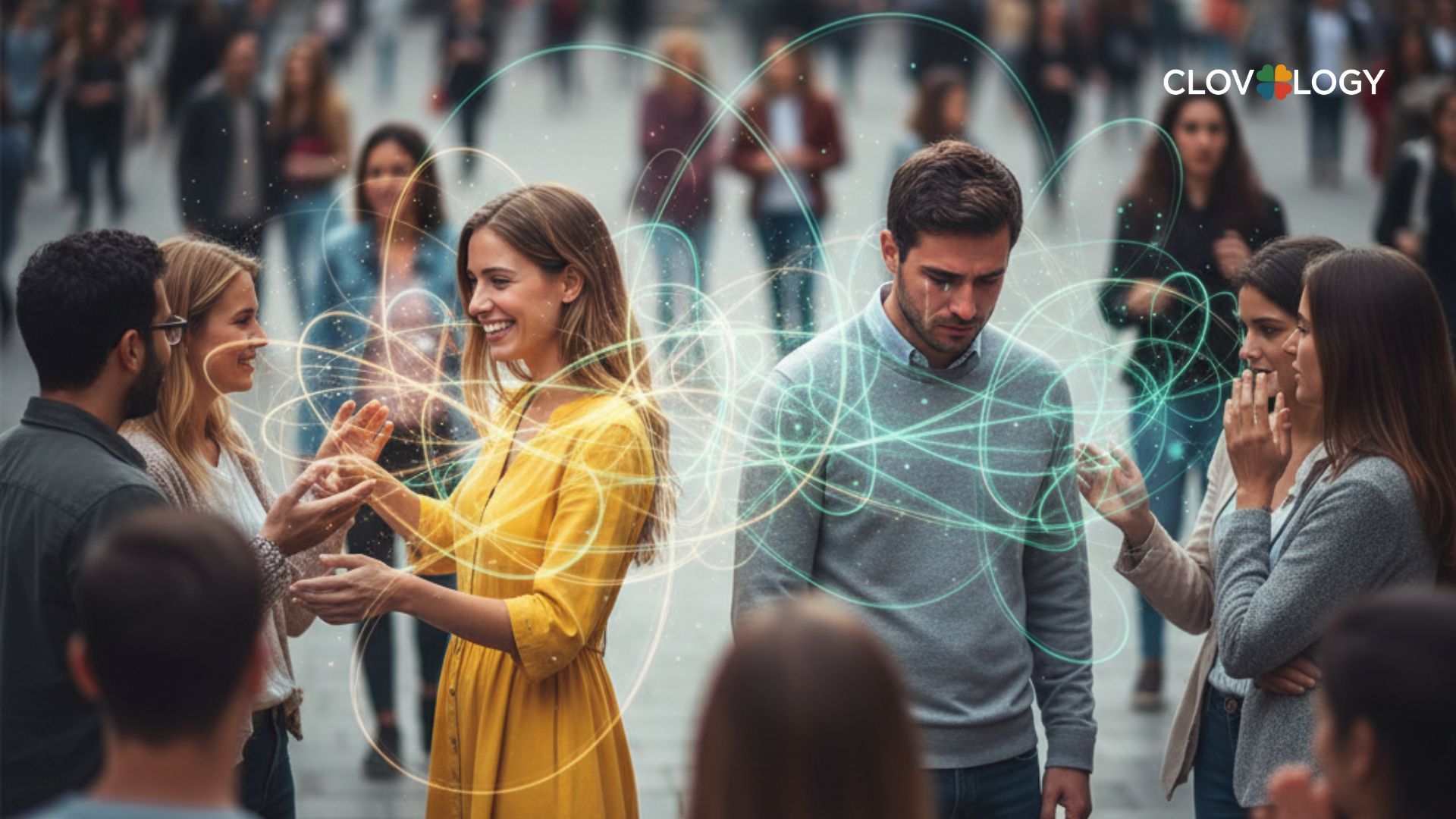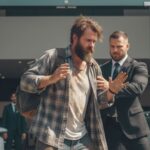There are moments we imagine a small cabin by the woods – phone off, every door shut, life alone among wind and wood. The thought tastes sweet. It promises a light life with no people, no mess. But a few steps later, one truth emerges: wherever we retreat, humans live by relationships. We breathe air someone kept clean, drink water from a system someone runs, think in a language a community handed us, and remember faces that once touched our life. We can hide for a tired day, but we cannot live outside the gravitational field of human-to-human life.
Cloverlogy stands in a clear position: life is not the story of a solitary individual, but the flow of countless connections. Life operates within a field of relationships across many layers: the inner self, person-to-person, shared rules and institutions, and the surrounding ecology and technology. Among these, the person-to-person layer is the closest drive train to our everyday experience. This is not a slogan. It’s a way to lay a foundation for reading reality clearly, so we don’t slide into dogma or illusions.

The central claim: stand in the right place to see clearly
Cloverlogy’s statement can be packed into two lines:
- Life runs within a field of multiple relational layers: with ourselves, with other people, with the shared rules of the game, and with environment and technology.
- The person-to-person layer is the nearest drive train, where the voltage of emotion, the making of meaning, and the energy for action touch us every day.
This claim does not deny quiet time. A human being has the right to be alone and the need for private space to breathe. But solitude is a breath within a shared song, not an excuse to switch off the orchestra. In other words, healthy aloneness lives inside the relational field. Extreme isolation is an illusion.
Related reading, What is Health?
The four-layer map: minimalist, not simplistic
To avoid abstract debates, let’s look at the four layers as a minimalist map – simple enough to read life, but not rigid.
- With ourselves: the inner voice, memories, values, beliefs. This is the control panel. Which switch flips on, which volume turns up, which frequency opens – these choices largely shape how we step out to meet others.
- With others: family, friends, coworkers, neighbors, strangers. This is the surface of the road. The wheels of everyday life roll here – smooth or squeaky, here and now.
- With rules and institutions: household norms, team principles, organizational culture, law. This is the rail. Without rails the train derails; with rails alone the train still won’t move without a driver.
- With environment and technology: physical space, urban rhythm, digital platforms, the conduits of information. This is the infrastructure. Clean conduits keep water clear; dirty conduits amplify noise.
These four layers are not separate boxes. They are four strands twisted into one cable. The inner life shapes interaction; institutions set the rules; technology amplifies what we send. But the core strand that touches our felt experience day by day remains person-to-person.

Person-to-Person: why we call it the drive train
Consider three streams that run through the person-to-person layer:
The emotional stream
Feelings rarely erupt in a vacuum. They usually flare when another person appears before us. A word of recognition loosens muscles. A dismissive look dries the throat. A brief sentence at the right time can recolor the entire afternoon. What we feel about ourselves in that moment – right or not yet right – is blended by interaction.
The meaning stream
Humans do not live by raw data; we live by meaning. Meaning is woven in dialogue. Faced with the same event, one friend may help us read opportunity; another may make us see threat. Trustworthy relationships are clear filters of meaning – less noise, more depth.
The energy stream
Energy flows when there is a fulcrum, a companion, a reminder at the right time. Most turning points in life are tied to a meeting: a handshake, a yes to do this together, a reply that wasn’t late, the signal “I’m here.” Feeling “part of a team” turns the hard into the doable.
These three streams explain why person-to-person contact hits us most directly. When they run well, the day clicks. When they grind, effort grows heavy – no matter how beautiful the goal.

The lone-life illusion: why it seduces and why it fails
The fantasy of living alone seduces because it simplifies human fatigue. We have been misunderstood, judged, treated unfairly. The mind defends itself by concluding: people cause the mess – avoid people, avoid mess. That conclusion is light in the first minute and costly in the days that follow.
Language is shared heritage
We think in words learned from others. Every term is a thread woven by the community. Leaving people does not erase language in the mind; it only cools its warmth and strips away the fine adjustments that live feedback provides.
Identity sprouts in reflection
The word “I” is not a primeval rock; it’s a mirror polished by other eyes. Everyone wants independence, but no one forms outside reflection. Walking away from others only turns the mirror into a dusty pane.
Basic needs are inter-human
Safety, recognition, belonging – these cannot be manufactured in a sealed room. Self-pep talks work for hours; lasting anchors come from another hand, another look, another presence.
Negation is still a relationship
Blocking, going silent, avoiding – these are all relational behaviors. The thread doesn’t vanish; it changes color. Negative relations are still relations – just tighter and colder.
Every skill bears a communal fingerprint
Even if you choose a forest life, you still use a blade someone forged, read a book someone wrote, raise a cabin on knowledge someone passed down. Cutting off others denies the fingerprints that carried you through thousands of days.
Alone vs. isolated: they differ in breath
Being alone with awareness is the rest in a shared score. It includes a time to return, a message – “I’m okay” – to someone, a door that opens again once the mind is steady. Extreme isolation shuts the music, breaks the rhythm, builds walls. There, fear swells, trust shrinks, time coagulates. The difference lies in breath: solitude still breathes with the world; isolation holds its breath.

Dignity, trust, belonging: three underground currents that set a space’s “human temperature”
Dignity
Every human carries value that needs no constant proof. When dignity is seen, language changes by itself – less sarcasm, more respect. Attitude changes – less back-channel swerving, more face-to-face feedback. Behavior changes – less lateness, more keeping one’s word.
Trust
Trust can’t be demanded; it must be built. Its sign is safety: finishing a sentence, repairing mistakes without public shaming, being different without being pushed to the edge. When safety arrives, people open.
Belonging
Belonging is not “joining at all costs,” but having a place to lay oneself down without being used and tossed. It grows from small repeated touches: speaking each other’s names, timely replies, quiet recognition.
These three currents set any place’s “human temperature.” Where they are warm, newcomers don’t shrink. Where they are cold, even insiders feel alone.
Freedom: not outside relationships, but growing within them
Cloverlogy understands freedom as the ability to be fully present in the midst of life. Freedom is not “no one can touch me,” but “I have clear boundaries, I know who I am, and I choose how I touch the world.” A timely hug doesn’t strip freedom; it releases us from contraction. A timely reminder doesn’t control; it opens another path. A free person doesn’t need to flee relationships because they don’t confuse stickiness with connection, flattery with respect, or resignation with partnership.
Technology: conduit, not source
Social networks, messaging apps, video calls, shared documents – these are conduits. Conduits can be clean or dirty, wide or narrow. But the water source is people. A text – “made it home” – lets somebody exhale. A careless comment can mute someone for a week. Forgetting this, we mistake anonymity for freedom. In reality, freedom expands when we stand behind how we touch others – online and off.
Institutions and people: rails and drivers
Processes, rules, laws, household norms – these are rails that let the train run smoothly. But rails cannot drive. Great process in cold hands becomes paperwork. Adequate process in warm hands becomes an invitation to collaborate. Where investment goes into right rails and warm people, long distances become short.
Reading life through the relational lens: a few shifts
When you place the relational lens over life, many images sharpen:
- Success stops being a bare number and becomes the smoothness of coordination.
- Crisis is not only an individual’s fault but often a signal of a broken section in the relational line.
- Lasting joy rarely comes from rare peaks; it comes from repeated, kind micro-interactions.
- Lingering sadness is not merely temperament; it’s the scar of not being heard, again and again.
This way of reading keeps us out of dogma because it forces us to see the threads, not just the grains of sand. It also keeps us from unreal thinking because it reminds us that results are the consequence of relationships.
Near-life scenes: simple mirrors that ring true
Dinner at home
No big philosophy needed. One person waits for the other to finish a sentence. Someone refills a cup that’s low. A short thank-you. The relational field is nourished by small, steady, durable gestures.
A fifteen-minute meeting
Someone starts with the shared goal and ends with who does what by when. Clarity is a form of respect. Respect reduces mind-reading and defensiveness, and increases collaboration.
An apology
I was wrong at point A, I’ll do B to repair it. Apology doesn’t make a person small; it makes the thread larger.
A stranger in the rain
You yield the lane; the other nods. Both move on, a bit warmer toward the world.
A welcome email to a new teammate
It includes: “Ping me if you’re stuck. I’m here.” That sentence costs nothing but anchors a newcomer – less acting, more asking, faster learning.
Neighbors and loud music
A gentle text, a request to lower the volume, a thank-you. Boundaries are clear and the connection stays warm. A calm street comes not only from regulations but from how people touch people.
These small scenes are contact points on a circuit. Where the contact is clean, current flows. Where it’s corroded, the light flickers.
Why Cloverlogy puts weight on person-to-person
Because in this layer life touches skin most clearly. Here dignity is honored or humiliated, trust sprouts or erodes, belonging expands or shrinks. The other layers matter, but when person-to-person grinds, everything else works twice as hard. When person-to-person runs smoothly, most hard things get easier.
We cannot escape – and we don’t need to
Refusing the truth that people live in a relational field creates a sweet but empty illusion. It’s like trying to breathe by willpower while forgetting air comes from forests others tend. The truth is lighter: we cannot escape, and we don’t need to. Seeing this, the mind panics less. We stop setting an unrealistic goal – sealing every door. We begin to read life on the right axis: which thread is warm, which is cold, where the rail is broken, where the driver has dozed. What remains belongs to the “how.” This essay stops at the level of perspective because a right foundation is the minimum before any methods.
Related reading, The essence of every relationship?

Closing: a position so we don’t get lost
Cloverlogy doesn’t want to sell instant formulas for living, and it refuses empty moralizing. We simply set up a road sign – clear but not coercive:
- Humans live within a relational field; no one stands outside it.
- The person-to-person layer is the nearest drive train to everyday experience.
- Running away from relationships is an illusion, because even negation is a form of relation.
- Happiness and performance do not drop from the sky; they grow from how threads are touched, held, and woven.
If life is a multi-level city, the person-to-person streets are where we actually live. There you’ll find laughter and argument, apology and an awkward hug, a nod at the crosswalk, a text that says “home safe.” There people tire and rest, then move on. There differences do not harden into trenches but become material for deeper understanding.
On some day you may still close the door for a few hours to rest. But that door opens so you can return to life as it is: faces, words, steps, a meal, a note greeting someone new, a nod to a stranger. No one lives well alone. No one needs to live well alone. Life operates in a relational field, and the person-to-person layer is the nearest drive train that touches each of our days. Seeing this simple truth, we pull ourselves back from dogma and daydreams and stand again on the ground – where human beings meet human beings and make a life.













